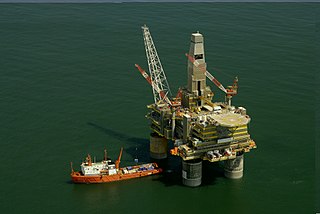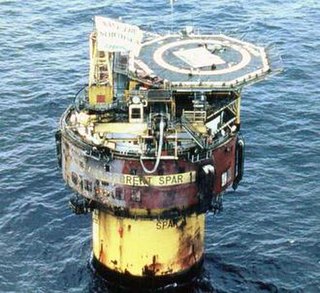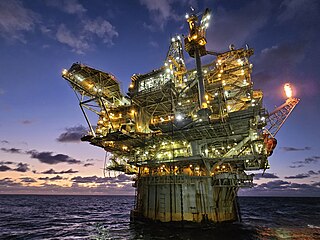
An oil platform is a large structure with facilities to extract and process petroleum and natural gas that lie in rock formations beneath the seabed. Many oil platforms will also have facilities to accommodate the workers, although it is also common to have a separate accommodation platform linked by bridge to the production platform. Most commonly, oil platforms engage in activities on the continental shelf, though they can also be used in lakes, inshore waters, and inland seas. Depending on the circumstances, the platform may be fixed to the ocean floor, consist of an artificial island, or float. In some arrangements the main facility may have storage facilities for the processed oil. Remote subsea wells may also be connected to a platform by flow lines and by umbilical connections. These sub-sea facilities may include one or more subsea wells or manifold centres for multiple wells.

Brent Spar, known as Brent "E", was a North Sea oil storage and tanker loading buoy in the Brent oilfield, operated by Shell UK. With the completion of a pipeline connection to the oil terminal at Sullom Voe in Shetland, the storage facility had continued in use, but by 1991, was considered to be of no further value. Brent Spar became an issue of public concern in 1995, when the British government announced its support for Shell's application for its disposal in deep Atlantic waters at North Feni Ridge.

Byford Dolphin was a semi-submersible, column-stabilised drilling rig operated by Dolphin Drilling, a Fred Olsen Energy subsidiary. It drilled seasonally for various companies in the British, Danish, and Norwegian sectors of the North Sea. It was registered in Hamilton, Bermuda. In 2019, Dolphin scrapped the rig.
The oil and gas industry is usually divided into three major sectors: upstream, midstream and downstream. The upstream sector includes searching for potential underground or underwater crude oil and natural gas fields, drilling exploratory wells, and subsequently operating the wells that recover and bring the crude oil or raw natural gas to the surface.
The ISO 15926 is a standard for data integration, sharing, exchange, and hand-over between computer systems.

Valhall is an oil field in the Norwegian sector of the North Sea. Discovered in 1975, production began in 1982 and is expected to continue until 2050. Valhall is located in 70 metres of water. It produces from chalk in the Tor and Hod Formations of Late Cretaceous age. The reservoir depth is approximately 2 400 metres.

The Germanischer Lloyd SE was a classification society based in the city of Hamburg, Germany. It ceased to exist as an independent entity in September 2013 as a result of its merger with Norway's DNV to become DNV GL.

Offshore drilling is a mechanical process where a wellbore is drilled below the seabed. It is typically carried out in order to explore for and subsequently extract petroleum that lies in rock formations beneath the seabed. Most commonly, the term is used to describe drilling activities on the continental shelf, though the term can also be applied to drilling in lakes, inshore waters and inland seas.

Equinor ASA is a Norwegian state-owned multinational energy company headquartered in Stavanger, Norway. It is primarily a petroleum company operating in 36 countries with additional investments in renewable energy. In the 2020 Forbes Global 2000, Equinor was ranked as the 169th-largest public company in the world. In 2023, the company was ranked 52nd in the same list. As of 2021, the company has 21,126 employees.
Sleipner A is a combined accommodations, production and processing offshore platform at the Sleipner East gas field in the Norwegian sector of the North Sea. It is a Condeep-type oil platform, built in Norway by the company Norwegian Contractors for Equinor.
Yme is an oil field in the Egersund basin area in the central part of the North Sea. It is located 160 kilometres (99 mi) northeast of the Ekofisk oil field. The water depth is 93 metres (305 ft). The field was discovered in 1987 and was developed by Statoil with production from 1996 to 2001. In 2001 low oil prices led to the abandonment of the field. After the production license was relinquished by Statoil, a new license group led by Talisman Energy was formed to redevelop the field. In 2007 Talisman was granted permission to redevelop the field. The redevelopment was unsuccessful and the newly installed Yme MOPU STOR was abandoned and decommissioned without having entered production. A new attempt called the Yme New Development was launched by the new operator Repsol, which involved reusing the subsea installations already in place. The Yme field began producing again in 2021, marking the first time that a previously abandoned Norwegian oil field has been restarted.

Grup Servicii Petroliere is a Romanian company providing offshore integrated services for oil and gas industry. The company, established in 2004, is a member of UPETROM Group.
In the petroleum industry, Integrated operations (IO) refers to the integration of people, disciplines, organizations, work processes and information and communication technology to make smarter decisions. In short, IO is collaboration with focus on production.
POSC Caesar Association (PCA) is an international, open and not-for-profit, member organization that promotes the development of open specifications to be used as standards for enabling the interoperability of data, software and related matters.
GL Noble Denton is one of the oil and gas businesses of DNV GL, headquartered in Hamburg, Germany and London, UK. The company is an independent technical advisor to industry operators across the world.
Model Driven Interoperability (MDI) is a methodological framework, which provides a conceptual and technical support to make interoperable enterprises using ontologies and semantic annotations, following model driven development (MDD) principles.
Integrated Software Dependent Systems (ISDS) is an offshore oil IT system standard (DNV-OS-D203) and recommended practice guideline (DNV-RP-D201) covering systems and software verifications and classification of any integrated system that utilizes extensive software control. The ISDS Recommended Practice (DNV-RP-D201) was launched in 2008 by Det Norske Veritas (DNV), the Norwegian classification society. DNV Offshore Standard OS-D203 launched in April 2010.
Sesam is a software suite for structural and hydrodynamic analysis of ships and offshore structures. It is based on the displacement formulation of the Finite Element Method.

Scarabeo 9 is a Frigstad D90-type ultra deepwater 6th generation semi-submersible drilling rig. It is owned and operated by Saipem. It was named by Anna Tatka, the wife of Pietro Franco Tali, CEO of Saipem. The vessel is registered in Nassau, Bahamas.

Scarabeo 8 is an ultra deepwater 6th generation semi-submersible drilling rig. It is owned and operated by Saipem. The vessel is registered in Nassau, Bahamas.










